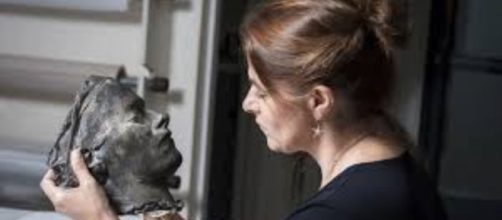Relationships are hard. They just are. Reams of poetry and songs attest to that. And while happy endings are also part of life, you wouldn’t know it by visual artist Tracy Emin’s autobiographical work that so constantly solemnizes her failed liaisons. You might say she’s made an art career out of misery with installations like “Everyone I Have Ever Slept With,” a tent marked with 102 names, and “My Bed” – an unmade, semen/menstrual blood-stained berth strewn with used condoms, empty vodka bottles and an ashtray badly in need of emptying.
Look at me, see me, please!
But as despairing as such views of her love life are, there’s a work in the news at the moment that is self-absorbed in another way: a 3D self-portrait she calls “Death Mask” just purchased by the National Portrait Gallery in London. Cast in bronze, it joins the treasure house’s 30-plus such masks of other artists like Constable and Turner. Narcissistic as ever, Emin even contributed to the purchase. Director Nicholas Cullinan lauds it as “one of the most striking and singular portraits to joining the gallery’s collection in recent years.” But the only “singular” thing that this column can see is that death masks get made after a person dies, not during the life of a busy 54-year old artist.
Probably the best known death mask comes from the ancient Nile in the golden form of King Tut’s head. If anything, Emin’s replication of her face should be tagged a Life Mask, which the gallery also collects.
A matter of life and death
What’s the point of a Life Mask? Consider the two cast of Abraham Lincoln, one made at the start of his administration and the other as the Civil War raged on.
The second mask shows a ravaged face made just two months before he was killed that tells the story of America in 1865. What does Emin’s Death Mask tells us? To hear exhibit curator Rab MacGibbon tell it to the press, Emin’s work “blurs the distinction between life and death.” Not according to her. Four photographic self-portraits showing with her mask, called “The Last thing I said to you is Don’t Leave Me Here,” suggests the fear of abandonment, which again point to those failed affairs objectified in her installations.
And as she has long been saying, to see her art is to see her. It follows that if the body of her work is intended as a self-portrait, then making herself into an objet d’art with a Death Mask was an historic inevitability.
The only question remaining is why not title it a life mask? As if in response, the Guardian quotes her saying that she made the work, which will be on display for a year, to offer herself in perpetuity. In that case, one is left wondering what Emin will do when the year is up and the need to expose herself again rears its needy head.

